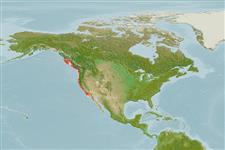>
Ovalentaria/misc (Various families in series Ovalentaria) >
Embiotocidae (Surfperches)
Etymology: Hyperprosopon: Greek, hyper = over + Greek, prosopon = face, snout of animal (Ref. 45335); ellipticum: From the Latin 'ellipticum' - referring to the outline of the body (Ref. 6885).
Environment: milieu / climate zone / depth range / distribution range
Écologie
marin démersal; profondeur 0 - 110 m (Ref. 2850). Subtropical; 56°N - 30°N, 135°W - 116°W
Eastern Pacific: southern British Columbia, Canada to Rio San Vincente, northern Baja California, Mexico.
Taille / Poids / Âge
Maturity: Lm ? range ? - ? cm
Max length : 27.0 cm TL mâle / non sexé; (Ref. 2850); âge max. reporté: 7 années (Ref. 56049)
Description synthétique
Clés d'identification | Morphologie | Morphométrie
Épines dorsales (Total) : 8 - 10; Rayons mous dorsaux (Total) : 25 - 28; Épines anales: 3; Rayons mous anaux: 29 - 34. Dark green dorsally, sides and belly silvery; a series of narrow vertical bars of pale golden pink on body wall; pectoral fins colorless (Ref. 6885). British Columbia specimens dark on end of caudal fin and free edge of spinous dorsal (Ref. 6885).
Found inshore, in surf and sandy areas, also occur around rocks and piers (Ref. 2850). Intertidal and to 110 m (Ref. 96339). Viviparous, female carries the developing young (Ref. 205). Frequently caught, but not of much importance as a sport fish due to its small size (Ref. 2850).
Life cycle and mating behavior
Maturité | Reproduction | Frai | Œufs | Fécondité | Larves
Viviparous, female carries the developing young (Ref. 205).
Eschmeyer, W.N., E.S. Herald and H. Hammann, 1983. A field guide to Pacific coast fishes of North America. Boston (MA, USA): Houghton Mifflin Company. xii+336 p. (Ref. 2850)
Statut dans la liste rouge de l'IUCN (Ref. 130435: Version 2024-2)
Menace pour l'homme
Harmless
Utilisations par l'homme
Pêcheries: commercial; pêche sportive: oui; Aquarium: Aquariums publics
Outils
Articles particuliers
Télécharger en XML
Sources Internet
Estimates based on models
Preferred temperature (Ref.
123201): 8.3 - 12.8, mean 9.8 °C (based on 64 cells).
Phylogenetic diversity index (Ref.
82804): PD
50 = 0.6250 [Uniqueness, from 0.5 = low to 2.0 = high].
Bayesian length-weight: a=0.01905 (0.00827 - 0.04391), b=2.97 (2.77 - 3.17), in cm total length, based on LWR estimates for this (Sub)family-body shape (Ref.
93245).
Niveau trophique (Ref.
69278): 3.3 ±0.5 se; based on size and trophs of closest relatives
Résilience (Ref.
120179): Milieu, temps minimum de doublement de population : 1,4 à 4,4 années (tm=3; tmax=7).
Fishing Vulnerability (Ref.
59153): Low vulnerability (17 of 100).
